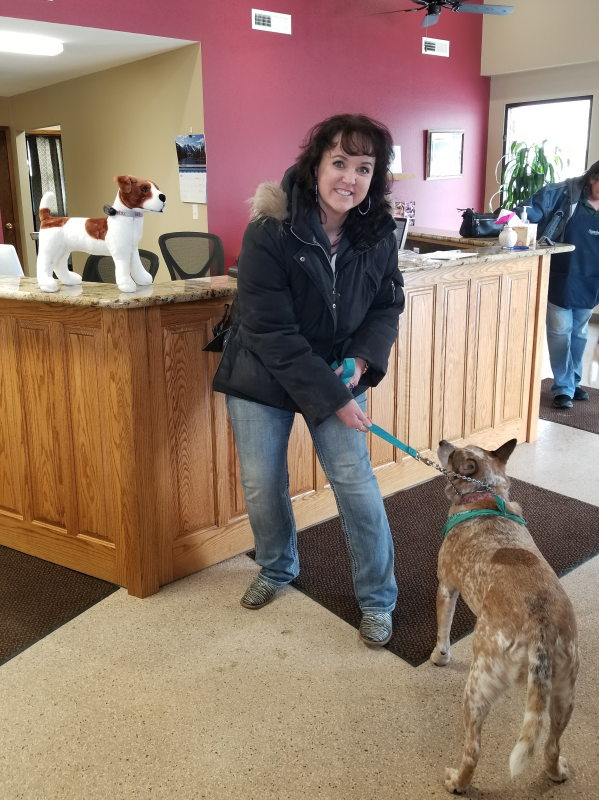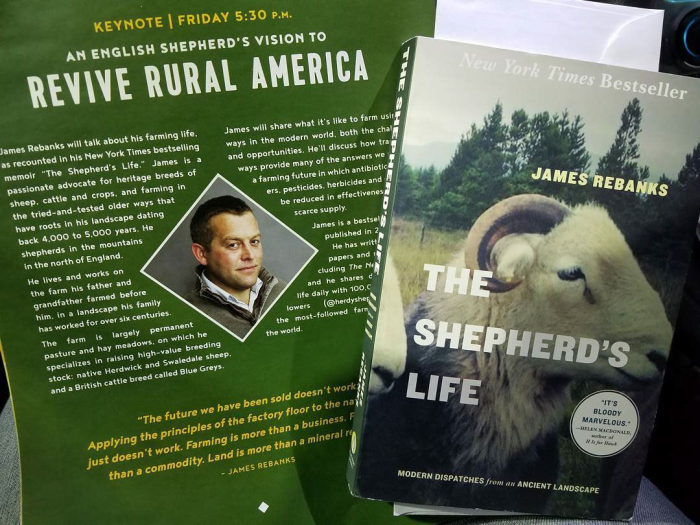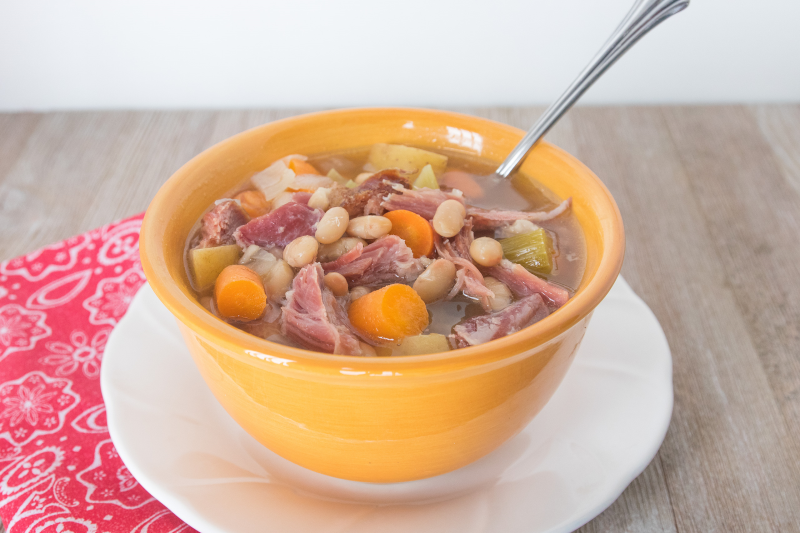Farm Life Journal - February 2018
February 12, 2018
By Darcy Maulsby
Greetings from the snowy fields of Calhoun County!
 It has been a challenge to keep warm this winter, hasn’t it? I love Iowa, but I sometimes get tired of the cold and snow.
It has been a challenge to keep warm this winter, hasn’t it? I love Iowa, but I sometimes get tired of the cold and snow.
The cold never stops my dog, Maggie. She’s an energetic red heeler/border collie mix who is an awesome farm dog, guard dog and all-around great buddy. She loves eating snow, playing Frisbee in all kinds of weather and going for rides. She’s also up for nearly anything, except climbing on the scale when it’s time to go to the Lake City Veterinary Clinic for her annual checkup. Maggie was a good girl, though, when she recently got her booster shots.
Taking good care of our animals is second nature for my family and my farmer friends. Just like you and I care for our pets, I’m inspired by how Iowa’s livestock farmers (including my neighbors) make it priority to provide their pigs and cows with proper nutrition, fresh water, a safe, comfortable living environment and veterinary care. Taking care of our livestock and pets is a year-round commitment, with no breaks for winter storms or holidays.
Beyond caring for animals, farming keeps us busy even when we’re not in the fields. This time of year, we’re preparing for the upcoming growing season, and I’ve been attending educational farm meetings around the state. I’m always intrigued how the topics covered at these meetings relate to everyone’s daily lives, whether you live on a farm or in a small town, suburb or city. Here are some stories worth sharing:
Food, fuel and agronomy — oh my! While our planters won’t be rolling around until April and May, my family met with our agronomist this winter to review the 2017 growing season and develop a plan for the corn and soybeans we’ll produce this year. What’s an agronomist, you ask? Agronomists are plant and soil scientists who specialize in innovative farm practices and technologies that not only boost crop yields, but also control pests and weeds while protecting the environment. Every day, everyone is affected by agronomy. The food you eat, the ethanol-based gas in your car or biofuel in your truck, the grass on the golf course or the natural fibers of the clothing you wear — all are influenced by agronomy.

Soil, sheep and a New York Times best-selling author/farmer. Did you know Iowa has 507 different types of soils? I loved learning tidbits like this at Practical Farmers of Iowa's (PFI) Soil Short Course in Ames in January. I also appreciated PFI’s keynote speaker, James Rebanks, the New York Times best-selling author of The Shepherd's Life: Modern Dispatches from an Ancient Landscape. Rebanks’ family has raised sheep in the Lake District of northwestern England for more than 600 years (yes, 600 years!). As a fellow farmer, I appreciated his comments about the realities and challenges of making a living in a rural area while honoring a way of life that’s worth preserving for future generations. As a fellow author, I loved his insights into the value of books — a perspective that took hold in his life years ago. “I realized that books are useful and exciting and could be about people like us,” said Rebanks, who now follows me on Twitter. How cool is that?
Biofuels and butterflies. Speaking of cool, I just learned about the Monarch Fueling Station Project, which is helping ethanol and biodiesel producers across Iowa create monarch butterfly habitats on the grassy areas surrounding biofuels plants. I heard about this when I attended the Iowa Renewable Fuels Summit in Altoona at the end of January. I was intrigued by the project, since pollinators are essential to our ecosystem and to agriculture. Because of their migratory patterns, monarchs need small patches of habitat, such as milkweed and wildflowers, throughout Iowa. Even one-tenth of an acre can make a difference, according to project leaders with the Monarch Fueling Station Project.
Lincolnway Energy near Nevada has started the process of establishing a monarch fueling station on a two-acre plot that’s being prepared for seeding in the spring. Converting grassy areas into monarch fueling stations, which support the monarch population, sounds like a great project to me. I’m wondering if I can do something similar on my land.
Why “too busy” isn’t in Coach Kent Stock’s vocabulary. Did you ever see the 2007 movie “The Final Season?” It was filmed in Iowa and starred Sean Astin, who also played the title role in the movie “Rudy.” Astin portrayed Coach Kent Stock, an Ankeny native and motivational speaker who spoke to the Iowa Soybean Association’s (ISA) District Advisory Council (DAC) meeting I attended in downtown Des Moines on January 30.
 What’s DAC Day you ask? Here’s a quote I shared with ISA to help promote the event: “DAC Day is like a family reunion and an excellent training seminar all rolled into one. I get to learn from other farmer leaders, plus the speakers are informative and inspiring. DAC Day motivates me to do even more to advocate for Iowa agriculture.”
What’s DAC Day you ask? Here’s a quote I shared with ISA to help promote the event: “DAC Day is like a family reunion and an excellent training seminar all rolled into one. I get to learn from other farmer leaders, plus the speakers are informative and inspiring. DAC Day motivates me to do even more to advocate for Iowa agriculture.”
Now, back to Coach Stock, who took on a huge challenge in the early 1990s in the small town of Norway (population 524 as of 2016) in northeast Iowa. Baseball was king in Norway, where the high school team had won many state championships through the years and prepared multiple players for professional baseball careers. When Norway’s high school had to merge with another school, Norway’s award-winning coach lost his job in the transition. Coach Stock led Norway’s players during the school’s last season, but the odds were against them. (I won’t give away the ending if you haven’t seen the movie.)
This inspiring film, which shows the power of community and the human spirit, became even more meaningful when Coach Stock told us about a letter he received from a fan in Minnesota after “The Final Season” debuted. While Coach Stock made a commitment early on to respond to everyone who contacted him, honoring that promise became overwhelming as fan mail, email and other requests kept pouring in following the movie’s release. While it would have been easier to say he was too busy, Coach Stock made time to respond to everyone, including the lady from Minnesota.
“Once in a while something good and pure comes into my life,” wrote the lady, who commended Coach Stock for honoring her with a reply. She added that his note was so meaningful to her because she was suffering from bone cancer.
“That’s why the words ‘too busy’ are not used in our home,” Coach Stock emphasized during DAC Day.
Talk about a story that sticks with you. Never underestimate the power you have to impact someone’s life.
Beyond preparing for the upcoming planting season and attending educational meetings, I’ve spent some time perfecting my favorite ham and bean soup recipe. With its rich broth and smoky undertones, there’s nothing like a hearty ham and bean soup to chase away the winter chill (or bitter cold, depending on what Mother Nature throws at us.)
I’ve never understood why a smoky, delicious ham and bean soup is so hard to find. Heck, just a lackluster, ho-hum ham and bean soup is often hard to find. I always figured no one knows more about ham and bean soup than Iowa farm cooks, especially when those who grew up on a hog farm like I did. Pork galore in all its forms was a staple on our family’s dinner table for generations. Plus, soup night was always Sunday night at our farm — and it still is. What a treat when ham and bean soup is on the menu!
Thanks for spending some time with me, my friends. I look forward to sharing more stories from the farm soon. I also like to hear your stories and questions related to food and farming. Don’t hesitate to reach out to me through the Iowa Food & Family Project or visit me online at www.darcymaulsby.com.
Take care!
Darcy
Darcy’s Hearty Ham and Bean Soup
 1 smoked ham hock (also called a smoked ham shank)—the meatier, the better
1 smoked ham hock (also called a smoked ham shank)—the meatier, the better- 1 48-ounce jar great northern beans (I don’t drain and rinse the beans—I add it all)
- 3 stalks celery, diced
- 3 carrots, peeled and sliced
- 3 to 4 medium potatoes, diced (I prefer Yukon Golds)
- 1 large onion, chopped
- 1 tablespoon garlic, minced
- 1 teaspoon fresh-ground pepper
- Water or chicken stock
- Salt, to taste
Place ham hock in slow cooker. Add beans, celery, carrots, potatoes, onion, garlic and pepper. Cover with water or chicken stock until slow cooker is full. (If using water rather than chicken stock, I often add 2 or 3 teaspoons of Better Than Bouillon chicken soup base to add more flavor.)
Cook on low for 8 to 10 hours. (I often prepare the soup in the evening and let it cook overnight.) Remove ham hock, allow it to cool, and remove ham from the bone. Add ham back to the soup. Taste the soup to see if it needs salt. Add salt, if desired. (Some ham hocks add enough flavor to the broth that no salt is needed.)
Note: Homemade soup often develops more flavor if you let it sit in the refrigerator overnight and serve the soup the next day. This Hearty Ham and Bean Soup is so good, though, that I understand if you dig in right away!